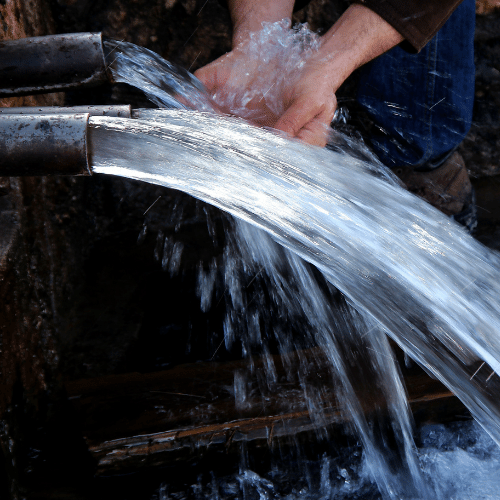In his defining work, English poet Samuel Taylor Coleridge tells the story of an elderly sailor recounting his adventures during a harrowing sea journey. At one point the ancient mariner in Coleridge’s poem says there was “Water, water everywhere, nor any drop to drink.”
Indeed, of all the water found on planet earth, only about 3% is fresh, and much of that is locked up in glaciers and polar icecaps. Water, particularly clean, drinkable water, has long been acknowledged as our most precious resource.
We sometimes take for granted that the water that flows from our taps has been treated and the piping components that make up its delivery path have been tested and certified as safe to be used in a potable water system.
The United States has set the benchmark for water quality that the rest of the world often looks to emulate. But how?
 What did the Safe Drinking Water Act do?
What did the Safe Drinking Water Act do?State and federal laws regarding water quality standards began to be enacted as early as the end of the 19th century. More recently the Safe Drinking Water Act (SDWA) authorized the Environmental Protection Agency (EPA) to set national standards to protect drinking water against naturally occurring and human-made contaminants.
The SDWA applies to every public water system in the United States. One of the major potential sources of contaminants are the products, components and materials that make up a plumbing system. First passed by congress in 1974, the SDWA has been amended several times and mandates actions to ensure drinking water, and its sources, remain protected and capable of delivering safe potable water.
A 1986 amendment to the act prohibited the use of certain items that were not “lead free”, then defined as containing no more than 8% lead.
In 2011, another change to the SDWA lowered the maximum lead content of the wetted surfaces of plumbing products to a weighted average of 0.25%, and established a calculation method for determining lead content called Annex G. This methodology is now contained in NSF/ANSI/CAN 372.
Throughout recorded history, lead has been acknowledged as unsafe for human consumption because it interferes with our brains, kidneys, and muscles, resulting in health issues such as anemia, hypertension, muscle aches, and disorientation.
Unlike many other toxins, the human body has no means to eliminate lead through excretion or metabolism. Once in our bodies, lead remains there forever. A common misconception is that NSF/ANSI/CAN 61 addresses lead only, when in fact it checks for other contaminants as well.
Founded in 1944 as an offshoot of the University of Michigan’s School of Public Health, the National Sanitation Foundation’s (now known as NSF International) mission of protecting and improving global human health got its start by standardizing sanitation and food safety requirements.
Since their auspicious beginning, NSF International has promulgated more than 80 public health and safety American National Standards, including NSF/ANSI/CAN 61 and 372.

In 1985, the EPA awarded a contract to a group of organizations lead by the National Sanitation Foundation (NSF International) to develop standards and a certification program for products used to treat or distribute drinking water. In 1988 NSF delivered NSF 61 Drinking Water System Components - Health Effects.
In 1989, NSF 61 became an American National Standards Institute (ANSI) accredited standard, and NSF began certifying products to the standard.
In 2008, the Annex G lead content requirement was introduced, which came about as a response to legislation stating what the maximum lead content of potable water products could be. California Assembly Bill 1953, and Vermont Senate Bill S 0.152 are two examples of the legislation.
In 2010, the Safe Drinking Water Act (SDWA) changed the requirement of "Lead-Free" to reflect the 0.25% or less lead content stipulated in Annex G; requirements were moved to NSF 372 Drinking Water System Components - Lead Content as a reference document to determine lead content (see below). Annex G was completely removed from NSF/ANSI 61 in 2013.
This new legislation went into effect in January 2014 compliance date was stipulated. Furthermore, NSF/ANSI 61 Section 3.5 also required all affected products meet the lead-free definition of the SDWA.
In 2019, NSF/ANSI 61 and 372 were approved as national standards in Canada, so now both are referred to as NSF/ANSI/CAN standards.
The testing of finished products is performed by exposing them to pH 5 and pH 10 waters at specified temperatures and analyzing the leachate for regulated metals such as antimony, arsenic, barium, cadmium, chromium, copper, lead, mercury, selenium, thallium, and nickel. Products are also exposed to pH 8 water and tested for organic chemical contaminants.
The pH of the water is a number that expresses its acidity or alkalinity on a logarithmic scale on which 7 is neutral with lower values being more acidic and higher values more alkaline.
To pass NSF/ANSI/CAN 61, the leachate from the testing must have contaminant levels below the total allowed concentrations for each that are deemed safe for human ingestion.
NSF/ANSI/CAN 372 Drinking Water System Components – Lead Content is an American National Standard that establishes a methodology for the determination and verification of product compliance to minimize lead contaminants.
The NSF/ANSI/CAN 372 standard includes a formula for calculating the weighted average lead content of each product and specific procedures for lead content testing.
NSF/ANSI/CAN 372 addresses lead content only by establishing a limit on the amount of lead that may be contained within individual plumbing products.
NSF/ANSI/CAN 61 establishes limits for lead and other contaminants that may migrate into drinking water from the plumbing products it flows through.
You can rest assured that the NSF/ANSI/CAN 61 and 372 certified products offered by Merit Brass are safe for use with potable water. Contact our team for more information.
Author: Marcus Estrella, Merit Brass Director of Product Line Management and John Higdon.
2/7/2025 7:11:42 AM